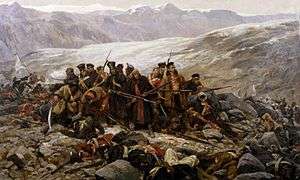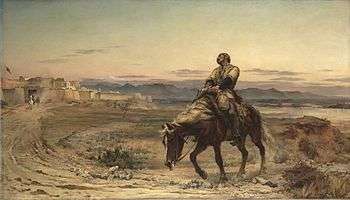44th (East Essex) Regiment of Foot
| 44th Regiment of Foot | |
|---|---|
| Active | 1741–1881 |
| Country | UK |
| Branch | Army |
| Role | Infantry |
| Size | 1–2 battalions |
| Nickname(s) | The Fighting Fours |
| Colours | Old colours of the 44th are laid up at Essex Regiment Chapel. |
| Commanders | |
| Notable commanders | James Long, Charles William Dunbar Staveley, Robert Montresor Rogers |
The 44th Regiment of Foot an infantry regiment in the British Army. After 1782 the regiment became known as the 44th (East Essex) Regiment of Foot. The lineage of the 44th transferred to the Essex Regiment in 1881. Through the process of amalgamation and restructuring of the Army, the lineage now rests with the 1st Battalion of the Royal Anglian Regiment.
Origins: Long's Regiment
The regiment was raised in 1741 as James Long's Regiment of Foot (the tradition at the time to name regiments after their Commanding Officers, in this case Colonel James Long). Long's Regiment saw active service in the Jacobite Rising (1745), including the Battle of Prestonpans, and served in Flanders (1748). Originally ranked as the 55th Regiment of the Line, the regiment was re-ranked as the 44th in 1748 following the disbandment of other regiments – the removal of the 11 Marine regiments from the British Army's numbering system.
Service in North America
The regiment was renamed the 44th Regiment of Foot in 1751 when British regiments ceased to be named for their Colonels. The regiment saw active service overseas in North America and participated in the French and Indian War and in the American Revolution. Notably, the regiment fought at Braddock's defeat (1755), the Battle of Carillon (1758), the Battle of Brooklyn (1776), the Battle of Brandywine (1777), and the Battle of Monmouth (1778).
In 1782, most British regiments of foot were given county designations, and the 44th became known as the 44th, or East Essex Regiment of Foot.
Napoleonic Wars (1792–1815)
1st Battalion, 44th Regiment of Foot
The regiment was increased in strength during the Napoleonic Wars and the original regimental strength (a single battalion) was organised as 1st Battalion. The 1st Battalion saw active service in Spain (1814) and North America (1814–1815). Notably, the battalion fought at the Battle of Bladensburg (1814), the Battle of North Point (1814), and the Battle of New Orleans (1815). [1]
2nd Battalion, 44th Regiment of Foot
The regiment increased in strength during the Napoleonic Wars and a new battalion was organised as 2nd Battalion in 1803. The 2nd Battalion saw active service in the Peninsular War and the Waterloo Campaign. Notably, the battalion fought at the Battle of Fuentes de Onoro (1811), the Siege of Badajoz (1812), the Battle of Salamanca (1812), the Battle of Quatre Bras (1815), and the Battle of Waterloo (1815). The battalion was disbanded in 1816 at the conclusion of the wars. [2]
Capture of French Imperial Eagle
The 2nd Battalion won great glory for the 44th at the Battle of Salamanca in 1812 when it captured the French Imperial Eagle, the equivalent of a British Regiment's Colours, of the French 62nd Regiment. The Eagle was carried on parade by the Essex Regiment, a tradition inherited by the 3rd Battalion The Royal Anglian Regiment and now the 1st Battalion.
First Anglo-Burmese War (1824–1826)
Under the command of Lieutenant Colonel John Shelton, the 44th Foot saw active service in the First Anglo-Burmese War. The 44th was serving as garrison in the Bengal Presidency, India and joined British and British East India Company regiments at Chittagong in January 1825. The regiment fought at Arakan on in March, capturing the city and then proceeding to clear the Arakan Province of enemy forces. Relatively few casualties were incurred during the fighting, but with the onset of the rainy season the European regiments (the 44th and the 54th) suffered from virulent fevers and dysentery until scarcely a man remained fit for duty. The regiment was awarded the battle honour "Ava" to its Regimental Colour. [3][4]
First Anglo-Afghan War (1839–1842)


The 44th Foot fought in the First Anglo-Afghan War and the regiment initially formed the advance and later the rearguard on the retreat from Kabul. After a continuous running battle in two feet of snow, the force had been reduced to fewer than forty men. On 13 January 1842, the few survivors of the decimated regiment made a last stand against Afghan tribesmen on a rocky hill near the village of Gandamak. The ground was frozen and icy. The men had no shelter and were starving. Only a dozen of the men had working muskets, the officers their pistols and a few unbroken swords. When the Afghans surrounded them on the morning of the 13th the Afghans announced that a surrender could be arranged. "Not bloody likely!" was the bellowed answer of one British sergeant. It is believed that only two survived the massacre. Most notable was Captain Thomas Souter, who by wrapping the regimental colours around himself was taken prisoner, being mistaken by the Afghan as a high military official. The other was Surgeon William Brydon who reached the British garrison at Jalalabad on the afternoon of the same day. A vivid, if romanticised, depiction entitled "Last Stand of the 44th Regiment at Gundamuk" was painted by the artist William Barnes Wollen in 1898 which now hangs in the Chelmsford and Essex museum in Oaklands Park, London Road, Chelmsford. This disaster to British arms served to encourage the Indian nationalists who were leaders in the great mutiny in India (1857).
Crimean War (1853–1855)
The 44th Foot was reconstituted and saw active service in Turkey and Russia during the Crimean War. The regiment was awarded three battle honours to its Regimental Colour for service in the Crimea.[5]
The Alma
The 44th served at the Battle of the Alma on 20 September 1854 as part of the 6th Brigade of 3rd Division, under command of General Sir Richard England.
Inkerman
The 44th served at the Battle of Inkerman on 5 November 1854 as part of the 2nd Brigade of 3rd Division, under command of General Sir Richard England. The division formed the British reserve during the battle. [6]
Sevastopol
The 44th served at the Siege of Sevastopol from September, 1854 to September, 1855. The regiment formed part of Sir William Eyre's brigade in 3rd Division. The regiment served throughout the long siege, and notably took part in the attack on dockyard creek on 18 June 1855 and the capture of the cemetery – the sole success achieved. [7] [8] Sevastapol cannon
Second Opium War (1857–1862)
The 44th Foot saw active service in China during the Second Opium War.
44th in China
The 44th were serving in Madras, India in 1860 as the garrison for Fort St George. Drafts of reinforcements arrived during 1859 and the regiment was composed of 35 officers and 1,176 organised in 10 companies. At the outbreak of war with China, 5 companies of the regiment embarked on transports on 31 January. The remainder of the regiment embarked on 3 March. On arrival in China the commanding officer Colonel Charles William Dunbar Staveley was appointed to command the 1st Brigade of the 1st Division, and command of the 44th fell to Lieutenant Colonel MacMahon.
Taku Forts
The regiment participated in the capture of the Taku Forts on 21 August 1860 as part of the Anglo-French forces under command of General Sir James Hope Grant. The 44th were in the vanguard of the assault on the North Taku entrenchments. The attacking force crossed a series of ditches and bamboo-stake palisades under heavy Chinese musketry, and tried to force entrance by the main gate. When this effort was unsuccessful, an assault party climbed the wall to an embrasure and forced entry to the fort. The first British officer to enter the fort was Lieutenant Robert Montresor Rogers of the E Company, who was awarded the Victoria Cross for his conspicuous bravery. He was closely followed by Private John McDougall who was also awarded the VC. During the fighting the 44th had Captain George Ingham and Lieutenant Robert Montressor Rogers severely wounded, fourteen men killed, one drummer and forty-five men wounded. For this bloody action the Essex Regiment was awarded the battle honor "Taku Forts" to its Regimental Colour. [9][10]
China Garrison Duty
On 25 August the 44th embarked for Shanghai and landed at the city on 10 September. The regiment garrisoned the city until 15 November when it embarked for Hong Kong, arriving 27 November. Lieut.-Colonel MacMahon was appointed commandant of the island, and command of the regiment passed to Brevet Lieutenant-Colonel Andrew Browne. One wing of the regiment garrisoned Hong Kong island, with the other quartered at Kowloon on the mainland. The regiment left China in October 1861 and returned to India.
In fiction
Sharpe
The capture of a French Imperial Eagle by the fictional South Essex Regiment in Bernard Cornwell's Sharpe novels is based upon the 2/44th's battle honour. The South Essex is depicted as having yellow coat facings like the 44th (East Essex). Sharpe's Waterloo again uses a historical incident involving the 44th as a backdrop for an action by the "South Essex", the back-to-back stand against French cavalry at the Battle of Quatre Bras.
Flashman
The retreat from Kabul and the events leading up to it form a major part of the plot of George MacDonald Fraser's novel Flashman. Flashman goes on to meet the regiment in Flashman at the Charge and Flashman and the Dragon, but they feature only as incidental colour. In the series Flashman names his house "Gandamak".
The Essex Regiment (1881)
On 1 July 1881, as part of the Childers Reforms which removed the numbering of Regiments, the 44th (East Essex) Regiment of Foot united with the 56th (West Essex) Regiment of Foot to form the Essex Regiment. [11]
Battle Honours
- Egypt
- Peninsular War: Badajoz, Salamanca, Peninsula
- War of 1812: Bladensburg
- Napoleonic Wars: Waterloo
- Anglo-Burmese War: Ava
- Crimean War: Alma, Inkerman, Sevastopol
- Second Opium War: Taku Forts
Victoria Crosses
Victoria Crosses were awarded to the following men of the regimant.
- Private John McDougall, Third China War (21 August 1860)
- Sergeant William McWheeney, Crimean War (20 October 1854)
- Lieutenant Robert Montresor Rogers, Third China War (21 August 1860)
Colonels of the Regiment
Colonels of the regiment were:[12]
- 1741–1743: Col. James Long
- 1743–1751: Col. John Lee
The 44th Regiment of Foot - (1751)
- 1751–1755: Col. Sir Peter Halkett, 2nd Baronet
- 1755–1756: Col. Robert Ellison
- 1756–1781: Gen. James Abercromby
- 1781–1809: Gen. Charles Rainsford
The 44th (East Essex) Regiment - (1782)
- 1809–1814: Gen. Sir Thomas Trigge, KB
- 1814–1820: Gen. John Howard, 15th Earl of Suffolk
- 1820–1843: Gen. Gore Browne
- 1843–1855: Gen. Hon. Sir Patrick Stuart, GCMG
- 1855–1858: Lt-Gen. Sir Frederick Ashworth
- 1858–1881: Gen. Sir Thomas Reed, GCB
References
- Carter, Thomas (1864). Historical Record of the Forty-Fourth, or the East Essex Regiment of Foot. London: W. O. Mitchell.
Notes
- ↑
- ↑
- ↑
- ↑ EXTRACT FROM THE RECORDS OF THE 54th WEST NORFOLK REGIMENT
- ↑
- ↑ INKERMAN, BATTLE
- ↑ The Siege of Sevastopol
- ↑ Sir Charles William Dunbar Staveley
- ↑
- ↑ Archived March 10, 2006, at the Wayback Machine.
- ↑ Archived March 10, 2006, at the Wayback Machine.
- ↑ "44th (East Essex) Regiment of Foot". regiments.org. Archived from the original on 29 December 2006. Retrieved 12 July 2016.